Henslin James M. Sociology: A Down to Earth Approach
Подождите немного. Документ загружается.


Types of Religious Groups
Sociologists have identified four types of religious groups: cult, sect, church, and ecclesia.
Why do some of these groups meet with hostility, while others tend to be accepted? For
an explanation, look at Figure 18.3.
Let’s explore what sociologists have found about these four types of religious groups.
The summary that follows is a modification of analyses by sociologists Ernst Troeltsch
(1931), Liston Pope (1942), and Benton Johnson (1963).
Cult
The word cult conjures up bizarre images—shaven heads, weird music, brainwashing—and
even ritual suicide may come to mind. Cults, however, are not necessarily weird, and few
practice “brainwashing” or bizarre rituals. In fact, all religions began as cults (Stark 1989).
A cult is simply a new or different religion whose teachings and practices put it at odds with
the dominant culture and religion. Because the term cult arouses such negative meanings
in the public mind, however, some scholars prefer to use the term new religion instead. As
is evident from the Cultural Diversity box on the next page, “new” can mean that an older
religion from one culture has made its appearance in a culture that is not familiar with it.
Cults often originate with a charismatic leader, an individual who inspires people be-
cause he or she seems to have extraordinary qualities. Charisma refers to an outstanding
gift or to some exceptional quality. People feel drawn to both the person and the message
because they find something highly appealing about the individual—in some instances,
almost a magnetic charm.
The most popular religion in the world began as a cult. Its handful of followers believed
that an unschooled carpenter who preached in remote villages in a backwater country
was the Son of God, that he was killed and came back to life. Those beliefs made the early
Christians a cult, setting them apart from the rest of their society. Persecuted by both re-
ligious and political authorities, these early believers clung to one another for support.
Types of Religious Groups 541
1. The organization is large
2. The organization is wealthy
3. The members are well to do (“worldly success”)
4. The clergy are required to have
years of formal training
Note: Any religious organization can be placed somewhere on this continuum, based on its having “more” or “less” of these characteristics
and emphases. The varying proportions of the rectangles are intended to represent the group’s relative characteristics and emphases.
The more that a group has these
emphases, the less it is accepted:
The more that a group has these characteristics,
the more the group is accepted:
1. The need to reject society
(the culture is a threat to true religion)
2. The group feels rejected by society
(the group feels hostility)
3. Hostility toward other religions
4. Hostility from other religions
5. Personal salvation
6. Emotional expression of religious beliefs
7. Revelation (God speaks directly to people)
8. God intervenes in people’s lives
(such as healing or giving guidance)
9. A duty to spread the message (evangelism)
10. A literal interpretation of scripture
11. A literal heaven and hell
12. A conversion experience is necessary
CHARACTERISTICS OF THE GROUPTHE GROUP EMPHASIZES
Church
Sect
Cult
Ecclesia
More acceptanceLess acceptance
FIGURE 18.3 Religious Groups: From Hostility to Acceptance
Sources: By the author. Based on Troeltsch 1931; Pope 1942; and Johnson 1963.
cult a new religion with few
followers, whose teachings and
practices put it at odds with
the dominant culture and reli-
gion
charismatic leader literally,
someone to whom God has
given a gift; in its extended
sense, someone who exerts
extraordinary appeal to a
group of followers
Charisma literally, an ex-
traordinary gift from God;
more commonly, an outstand-
ing,“magnetic” personality
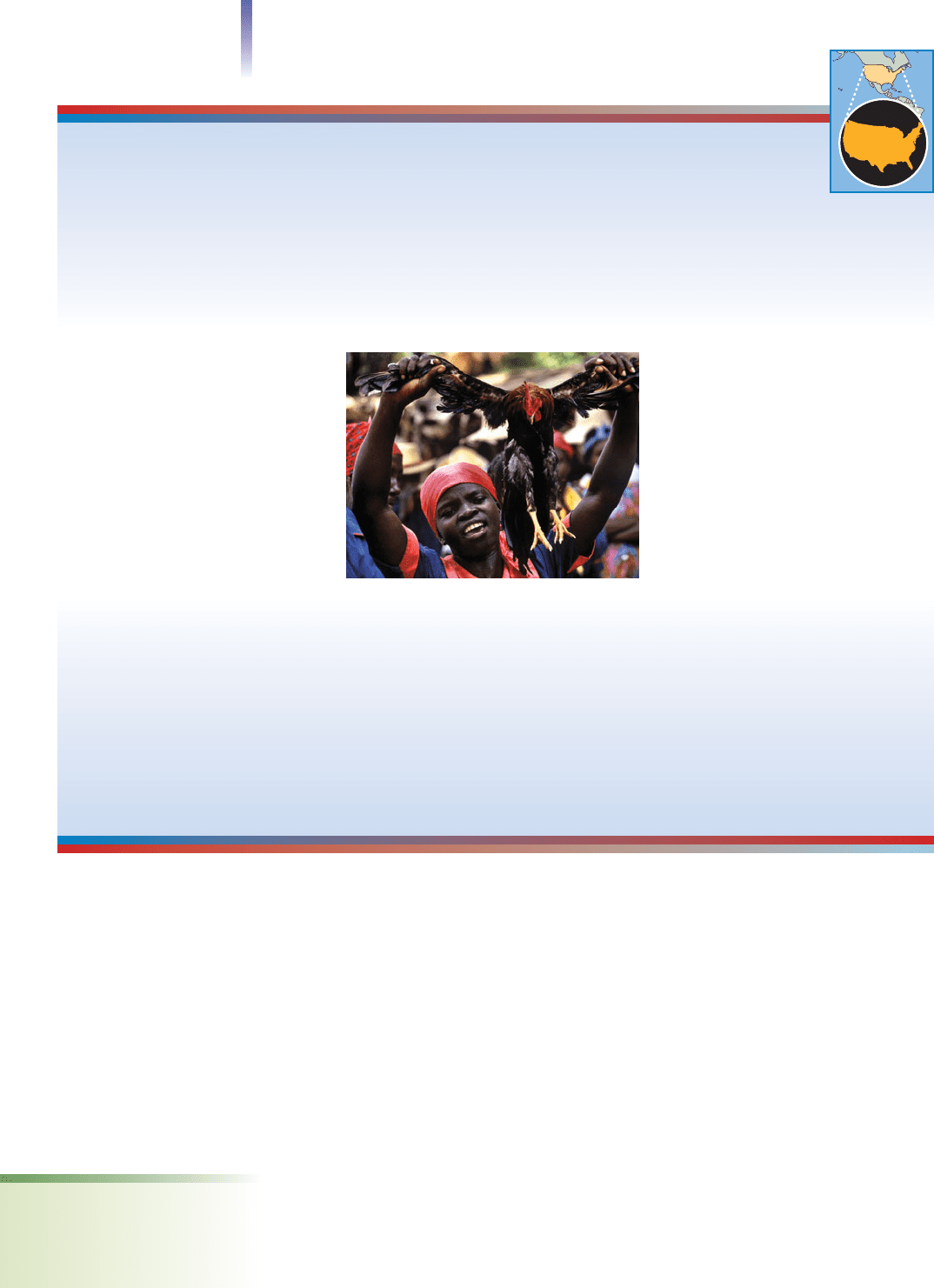
Many cut off associations with friends who didn’t accept the new message. To others, the
early Christians must have seemed deluded and brainwashed.
So it was with Islam. When Muhammad revealed his visions and said that God’s name was
really Allah, only a few people believed him. To others, he must have seemed crazy, deranged.
Each cult (or new religion) is met with rejection on the part of society. Its message is con-
sidered bizarre, its approach to life strange. Its members antagonize the majority, who are
convinced that they have a monopoly on the truth. The new religion may claim messages
from God, visions, visits from angels—some form of enlightenment or seeing the true way
to God. The cult demands intense commitment, and its followers, who are confronting a hos-
tile world, pull together in a tight circle, separating themselves from nonbelievers.
Most cults fail. Not many people believe the new message, and the cult fades into ob-
scurity. Some, however, succeed and make history. Over time, large numbers of people
may come to accept the message and become followers of the religion. If this happens, the
new religion changes from a cult to a sect.
Sect
A sect is larger than a cult, but its members still feel tension between their views and the
prevailing beliefs and values of the broader society. A sect may even be hostile to the so-
542 Chapter 18 RELIGION
Cultural Diversity in the United States
Human Heads and Animal
Blood:The Toleration of Religion
A
s the customs officials looked over the line of
people who had just gotten off the plane from
Haiti, there was nothing to make this particular
woman stand out. She would have
passed through without a problem,
except for one thing: As the cus-
toms agents gave her luggage a rou-
tine search, they found something
that struck them as somewhat un-
usual—a human head.
The head had teeth, hair, pieces
of skin, and some dirt. It had evi-
dently been dug up from some
grave, probably in Haiti.
The 30-year-old woman, who
lives in Florida, practiced Voodoo.The
head was for her religious rituals.
The woman was arrested. She
faces up to 15 years in prison for the crime of not filing a
report that she was carrying “organic material” (“Mujer
con Cabeza . . .” 2006).
* * * * *
The Santeros from Cuba who live in Florida sacrifice
animals.They meet in apartments, where, following a
Yoruba religion, they kill goats and chickens.
Calling on their gods, they first ask permission to sacri-
fice the animals. After sacrificing them, they pour out
the animals’ blood, which opens and closes the doors of
their destiny.They also cut off the animals’ heads and
place them at locations in the city that represent the
four directions of a compass. This is done to terrorize
their enemies and give them safety.
The sacrificed heads also protect
the city from hurricanes and other
destructive forces.
When city officials in Hialeah,
Florida, learned that the Santeros
were planning to build a church in
their city, they passed a law against
the sacrifice of animals within the city
limits. The Santeros appealed to the
U.S. Supreme Court, claiming discrim-
ination, because the law was directed
against them. The Court ruled in
their favor.
For Your Consideration
What do you think the limitations on religious freedom
should be? Should people be allowed to sacrifice ani-
mals as part of their religious practices?
If the Santeros can sacrifice animals, why shouldn’t
people who practice Voodoo be able to use human
heads if they want to? (Assume that the relatives of the
dead person have given their permission.)
A follower of voodoo holding a chicken before it is
sacrificed to the deity of fertility.
United States
United States
sect a religious group larger
than a cult that still feels sub-
stantial hostility from and to-
ward society
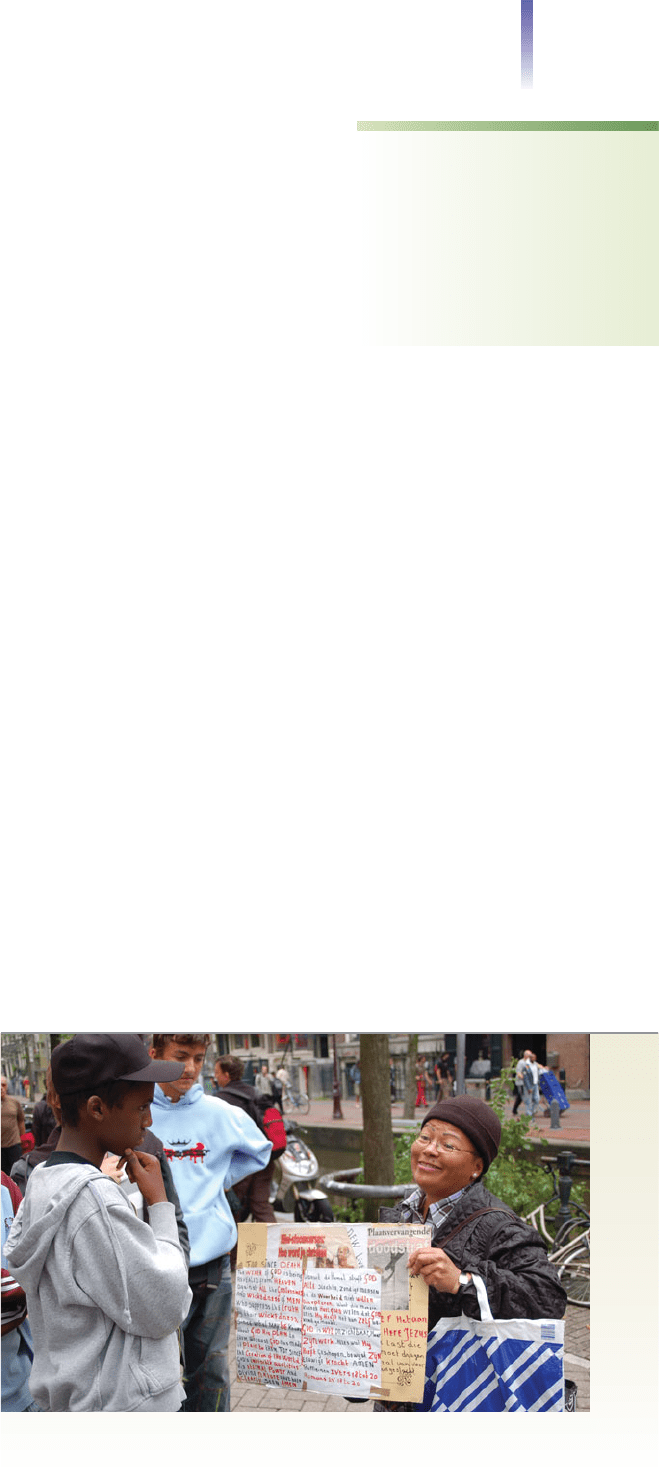
Types of Religious Groups 543
ciety in which it is located. At the very least, its members remain uncomfortable with
many of the emphases of the dominant culture; in turn, nonmembers tend to be uncom-
fortable with members of the sect.
Ordinarily, sects are loosely organized and fairly small. They emphasize personal salva-
tion and an emotional expression of one’s relationship with God. Clapping, shouting,
dancing, and extemporaneous prayers are hallmarks of sects. Like cults, sects also stress
evangelism, the active recruitment of new members.
If a sect grows, its members tend to gradually make peace with the rest of society. To
appeal to a broader base, the sect shifts some of its doctrines, redefining matters to remove
some of the rough edges that create tension between it and the rest of society. As the mem-
bers become more respectable in the eyes of the society, they feel less hostility and little,
if any, isolation. If a sect follows this course, as it grows and becomes more integrated
into society, it changes into a church.
Church
At this point, the religious group is highly bureaucratized—probably with national and in-
ternational headquarters that give direction to the local congregations, enforce rules about who
can be ordained, and control finances. The relationship with God has grown less intense.
The group is likely to have less emphasis on personal salvation and emotional expression.
Worship services are likely to be more sedate, with sermons more formal, and written prayers
read before the congregation. Rather than being recruited from the outside by fervent, per-
sonal evangelism, most new members now come from within, from children born to exist-
ing members. Rather than joining through conversion—seeing the new truth—children may
be baptized, circumcised, or dedicated in some other way. At some designated age, children
may be asked to affirm the group’s beliefs in a confirmation or bar mitzvah ceremony.
Ecclesia
Finally, some groups become so well integrated into a culture, and so strongly allied with
their government, that it is difficult to tell where one leaves off and the other takes over.
In these state religions, also called ecclesia, the government and religion work together to
try to shape society. There is no recruitment of members, for citizenship makes everyone
a member. For most people in the society, the religion is part of a cultural identity, not an
eye-opening experience. Sweden provides a good example of how extensively religion and
government intertwine in an ecclesia. In the 1860s, all citizens had to memorize Luther’s
Small Catechism and be tested on it yearly (Anderson 1995). Today, Lutheranism is still
associated with the state, but most Swedes
come to church only for baptisms, marriages,
and funerals.
Unlike cults and sects, which perceive God
as personally involved with and concerned
about an individual’s life, ecclesias envision God
as more impersonal and remote. Church serv-
ices reflect this view of the supernatural, for
they tend to be highly formal, directed by min-
isters or priests who, after undergoing rigorous
training in approved schools or seminaries, fol-
low prescribed rituals.
Examples of ecclesia include the Church of
England (whose very name expresses alignment
between church and state), the Lutheran
church in Norway and Denmark, Islam in Iran
and Iraq, and, during the time of the Holy
Roman Empire, the Roman Catholic Church,
which was the official religion for the region
that is now Europe.
evangelism an attempt to
win converts
ecclesia a religious group so
integrated into the dominant
culture that it is difficult to tell
where the one begins and the
other leaves off; also called a
state religion
Like other aspects of culture, religion is filled with background assumptions that
usually go unquestioned. In this photo, which I took in Amsterdam, what
background assumption of religion is this woman violating?

Variations in Patterns
Obviously, not all religious groups go through all these stages—from cult to sect to
church to ecclesia. Some die out because they fail to attract enough members. Others,
such as the Amish, remain sects. And, as is evident from the few countries that have
state religions, very few religions ever become ecclesias.
In addition, these classifications are not perfectly matched in the real world. For ex-
ample, although the Amish are a sect, they place little or no emphasis on recruiting oth-
ers. The early Quakers, another sect, shied away from emotional expressions of their
beliefs. They would quietly meditate in church, with no one speaking, until God gave
someone a message to share with others. Finally, some groups that become churches
may retain a few characteristics of sects, such as an emphasis on evangelism or a personal
relationship with God.
Although all religions began as cults, not all varieties of a particular religion begin
that way. For example, some denominations—“brand names” within a major religion,
such as Methodism or Reform Judaism—begin as splinter groups. Some members of a
church disagree with particular aspects of the church’s teachings (not its major message),
and they break away to form their own organization.
When Religion and Culture Conflict
As we have seen, cults and sects represent a break with the past. This division presents a
challenge to the social order, and often generates hostility. When religion and the cul-
ture in which it is embedded find themselves in conflict, how do they adapt?
First, the members of a religion may reject the dominant culture and have as lit-
tle as possible to do with nonmembers of their religion. Like the Amish, they may
withdraw into closed communities. As noted in the Cultural Diversity box on page
107, the Amish broke away from Swiss-German Mennonites in 1693. They try to
preserve the culture of their ancestors, who lived in a simpler time when there were
no televisions, movies, automobiles, computers—or even electricity. To do so, they
emphasize family life and traditional male and female roles. They continue to wear
the style of clothing that their ancestors wore three hundred years ago, to light their
homes with oil lamps, and to speak German at home and in church. They also con-
tinue to reject radio, television, motorized vehicles, and education beyond the eighth
grade. They do mingle with non-Amish when they shop in town—where their trans-
portation (horse-drawn carriages), clothing, and speech set them apart.
In the second pattern, a cult or sect rejects only specific elements of the prevailing
culture. For example, religious teachings may dictate that immodest clothing—short
skirts, skimpy swimsuits, low-cut dresses, and so on—is immoral or that wearing
makeup or going to the movies is wrong. Most elements of the main culture, however,
are accepted. Although specific activities are forbidden, members of the religion are
able to participate in most aspects of the broader society. They resolve this mild ten-
sion either by adhering to the religion or by “sneaking,” doing the forbidden acts on
the sly.
In the third pattern, the society rejects the religious group. Our opening vignette
focused on an example, the seizure by Texan authorities of children from a Mormon
splinter group. In the extreme, as with the early Christians, political leaders may
even try to destroy the group. The Roman emperor declared the followers of Jesus
to be enemies of Rome and ordered them to be hunted down and destroyed. In the
United States, after mobs hounded the new Mormons out of several communities
and then killed Joseph Smith, the founder of their religion, the Mormons decided
to escape the dominant culture altogether. In 1847, they settled in a wilderness, in
what is today Utah’s Great Salt Lake Valley (Bridgwater 1953). The most remarkable
example in the United States within the past couple of decades occurred in 1993
when U.S. authorities attacked and destroyed a cult called the Branch Davidians.
Including the twenty-five children who died huddled next to their mothers, more
than eighty people died.
544 Chapter 18 RELIGION
denomination a “brand
name” within a major religion;
for example, Methodist or
Baptist
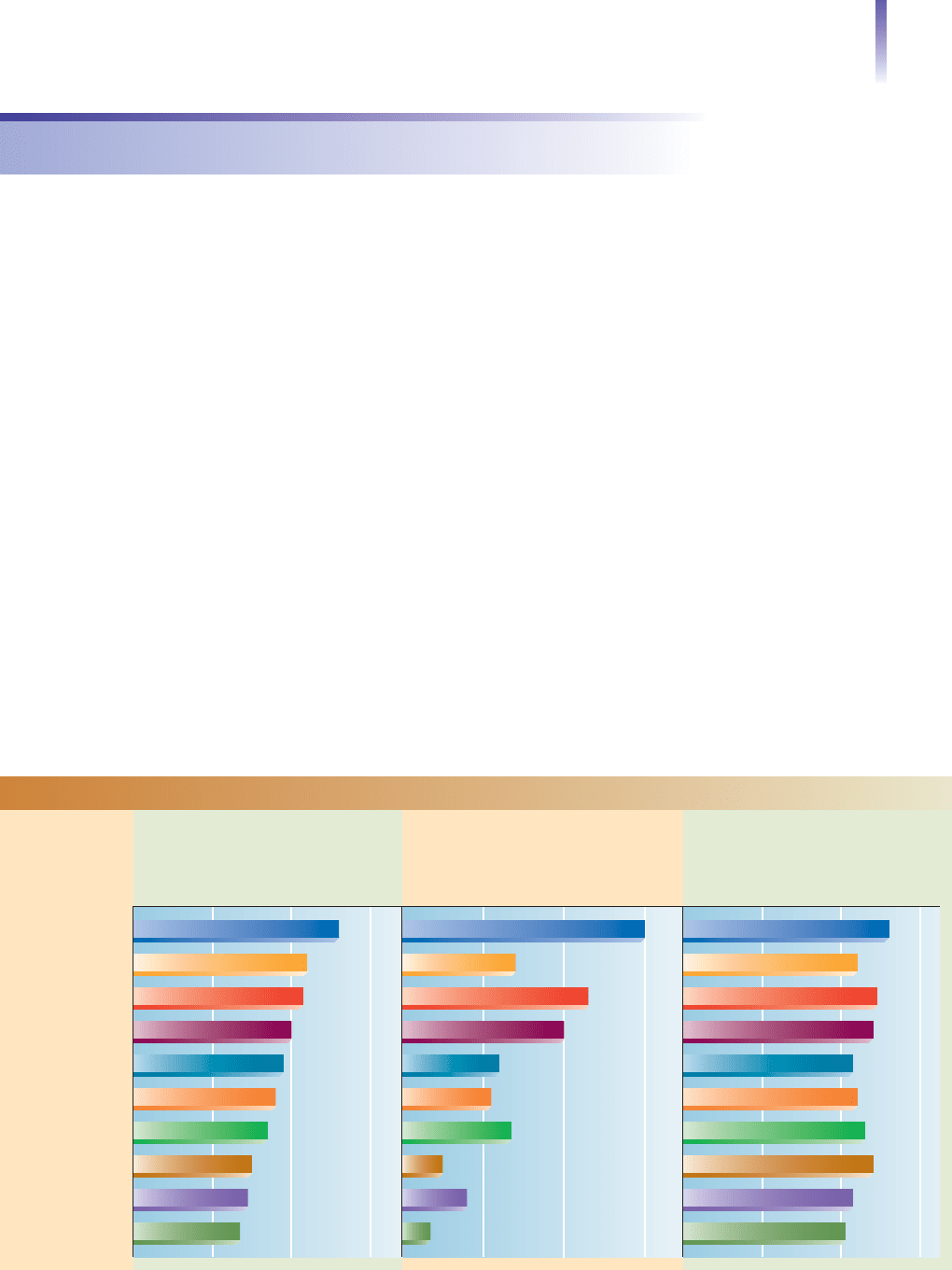
Religion in the United States
To better understand religion in U.S. society, let’s first find out who belongs to religious
groups and then look at the groups they belong to.
Characteristics of Members
About 65 percent of Americans belong to a church, synagogue, or mosque. What are the
characteristics of people who hold formal membership in a religion?
Social Class. Religion in the United States is stratified by social class. As you can see from
Figure 18.4 below, some religious groups are “top-heavy,” and others are “bottom-heavy.”
The most top-heavy are Jews and Episcopalians; the most bottom-heavy are Assembly of
God, Southern Baptists, and Jehovah’s Witnesses. This figure provides further confirma-
tion that churchlike groups tend to appeal to people who have more “worldly” success,
while the more sectlike groups attract people who have less “worldly” success.
From this figure, you can see how status consistency (a concept we reviewed in Chapter 10,
page 268) applies to religious groups. If a group ranks high (or low) on education, it is also
likely to rank high (or low) on income and occupational prestige. Jews, for example, rank the
highest on education, income, and occupational prestige, while Jehovah’s Witnesses rank the
lowest on these three measures of social class. As you can see, the Mormons are status incon-
sistent. They rank second in income, fourth in education, and tie for sixth in occupational
prestige. Even more status inconsistent is the Assembly of God. Their members tie for third
in occupational prestige but rank only eighth in income and ninth in education. This incon-
sistency is so jarring that there could be a problem with the sample.
Americans who change their social class also tend to change their religion. Their new
social class experiences create changes in their ideas about the world, molding new
preferences for music and styles of speech. Upwardly mobile people are likely to seek
Religion in the United States 545
Jewish
Episopal
Presbyterian USA
Mormon
Lutheran
(Missouri Synod)
Roman Catholic
Southern Baptist
Assembly of God
Jehovah's Witness
Occupational Prestige
2
Family Income
1
Education: Percent with
College Degrees
0
20 40 60
$0
$20
Thousands
$40 $60
0%
20%
Percentage
40% 60%
52
48
44
43
44
43
48
41
49
60%
40%
28%
24%
22%
16%
10%
7%
46%
$52,000
$40,000
$44,000
$38,000
$36,000
$29,000
$30,000
$27,000
$43,000
United Methodist 4627%$34,000
FIGURE 18.4 Social Class and Religious Affiliation
Source: By the author. Based on Smith and Faris 2005.
1
Since the income data were reported, inflation has run approximately 27 percent.
2
Higher numbers mean that more of the group’s members work at occupations that have higher prestige, generally those that
require more education and pay more. For more information on occupational prestige, see Table 10.2 on page 267.

a religion that draws more affluent people. An upwardly mobile Baptist, for example, may
become a Methodist or a Presbyterian. For Roman Catholics, the situation is somewhat
different. Because each parish is a geographical unit, Catholics who move into more af-
fluent neighborhoods are also likely to be moving to a congregation that has a larger pro-
portion of affluent members.
Race–Ethnicity. It is common for religions around the world to be associated with
race–ethnicity: Islam with Arabs, Judaism with Jews, Hinduism with Indians, and Con-
fucianism with Chinese. Sometimes, as with Hinduism and Confucianism, a religion and
a particular country are almost synonymous. Christianity is not associated with any one
country, although it is associated primarily with Western culture.
In the United States, all major religious groups draw from the nation’s many racial–
ethnic groups. Like social class, however, race–ethnicity tends to cluster. People of Irish
descent are likely to be Roman Catholics; those with Greek ancestors are likely to belong
to the Greek Orthodox Church. African Americans are likely to be Protestants—more
specifically, Baptists—or to belong to fundamentalist sects.
Although many churches are integrated, it is with good reason that Sunday morning
between 10 and 11
A.M. has been called “the most segregated hour in the United States.”
African Americans tend to belong to African American churches, while most whites see
only whites in theirs. The segregation of churches is based on custom, not on law.
Characteristics of Religious Groups
Let’s examine features of the religious groups in the United States.
Diversity. With its 300,000 congregations and hundreds of denominations, no religious
group even comes close to being a dominant religion in the United States (Statistical
Abstract 2011:Table 76). Table 18.1 illustrates some of this remarkable diversity.
546 Chapter 18 RELIGION
Christian 176,000,000 78.4%
Protestant 115,000,000 51.3%
Evangelical churches 59,000,000 26.3%
Mainline churches 41,000,000 18.1%
Historical black churches 16,000,000 6.9%
Roman Catholic 54,000,000 23.9%
Mormon 3,800,000 1.7%
Jehovah’s Witness 1,600,000 0.7%
Orthodox, Greek, Russian 1,400,000 0.6%
Other Christian 700,000 0.3%
Other Religions 11,000,000 4.7%
Jewish 3,800,000 1.7%
Buddhist 1,600,000 0.7%
Muslim 1,400,000 0.6%
Hindu 900,000 0.4%
Other faiths 2,700,000 1.2%
(Unitarians, New Age, Native
American religions, Liberal)
No Identity with a Religion 36,000,000 16.1%
Nothing in particular 27,000,000 12.1%
Agnostic 5,400,000 2.4%
Atheist 3,600,000 1.6%
Don’t Know or Refused 1,800,000 0.8%
Religious Group Number of Members Percentage of U.S. Adults
TABLE 18.1 How U.S. Adults Identify with Religion
Source: U.S. Religious Landscape Survey 2008:5.
Note: Due to rounding, totals may not add to 100. Based on a sample of 35,000 of the 225 million Americans age 18 and over.

Pluralism and Freedom. It is the U.S. government’s policy not to interfere with religions.
The government’s position is that its obligation is to ensure an environment in which peo-
ple can worship as they see fit. Religious freedom is so extensive that anyone can start a church
and proclaim himself or herself a minister, revelator, or any other desired term. The excep-
tions to this hands-off policy are startling. As mentioned, the most notorious exception in re-
cent times occurred in Waco, Texas. When armed agents of the Bureau of Alcohol, Tobacco,
and Firearms attacked the compound of the Branch Davidians, an obscure religious group,
eighty-two men, women, and children were burned to death. A second example is the focus
of this chapter’s opening vignette. A third is the government’s infiltration of mosques to mon-
itor the activities of Arab immigrants (Elinson 2004). Other limitations to this policy are dis-
cussed in the Cultural Diversity box on page 542.
Competition and Recruitment. The many religious groups of the United States compete
for clients. They even advertise in the Yellow Pages of the telephone directory and insert
appealing advertising—under the guise of news—in the religion section of the Saturday
or Sunday edition of the local newspapers
Commitment. Americans are a religious people, and 42 percent report that they attend re-
ligious services each week (Gallup Poll 2008b). Sociologists have questioned this statistic,
suggesting that the high total is due to an interviewer effect. Because people want to please in-
terviewers, they stretch the truth a bit. To find out, sociologists Stanley Presser and Linda
Stinson (1998) examined people’s written reports (no interviewer present) on how they spent
their Sundays. They concluded that about 30 percent or so do attend church each week.
Whether the percentage of weekly church attendance is 30 or 42, Americans are a re-
ligious people, and they back up their commitment with generous support for religion and
its charities. Each year Americans donate about $100 billion to religious causes (Statistical
Abstract 2011:Table 578). To appreciate the significance of this huge figure, keep in mind
that, unlike a country in which there is an ecclesia, those billions of dollars are not forced
taxes, but money that people give away.
Toleration. The general religious toleration of Americans can be illustrated by three pre-
vailing attitudes: (1) “All religions have a right to exist—as long as they don’t try to brain-
wash or hurt anyone.” (2) “With all the religions to choose from, how can anyone tell
which one—if any—is true?” (3) “Each of us may be convinced about the truth of our
religion—and that is good—but don’t be obnoxious by trying to convince others that
you have the exclusive truth.”
Fundamentalist Revival. As discussed in the Cultural Diversity box on the next page, the
fundamentalist Christian churches are undergoing a revival. They teach that the Bible is
literally true and that salvation comes only through a personal relationship with Jesus
Christ. They also denounce what they see as the degeneration of U.S. culture: flagrant sex
on television, in movies, and in videos; abortion; corruption in public office; premarital
sex and cohabitation; and drug abuse. Their answer to these problems is firm, simple,
and direct: People whose hearts are changed through religious conversion will change
their lives. The mainstream churches, which offer a more remote God and less emotional
involvement, fail to meet the basic religious needs of large numbers of Americans.
One result is that mainstream churches are losing members while the fundamentalists
are gaining them. Figure 18.5 on page 549 depicts this change. The exception is the
Roman Catholic Church, whose growth in North America is due primarily to immigra-
tion from Mexico and other Roman Catholic countries.
The Electronic Church. What began as a ministry to shut-ins and those who do not
belong to a church blossomed into its own type of church. Its preachers, called “televan-
gelists,” reach millions of viewers and raise millions of dollars. Some of its most famous
ministries are those of Joyce Meyers, Pat Robertson (the 700 Club), Benny Hinn, Creflo
Dollar, Kenneth Copeland, and Joel Osteen.
Many local ministers view the electronic church as a competitor. They complain that it
competes for the attention and dollars of their members. Leaders of the electronic church
reply that the money goes to good causes and that through its conversions, the electronic
church feeds members into the local churches, strengthening, not weakening them.
Religion in the United States 547
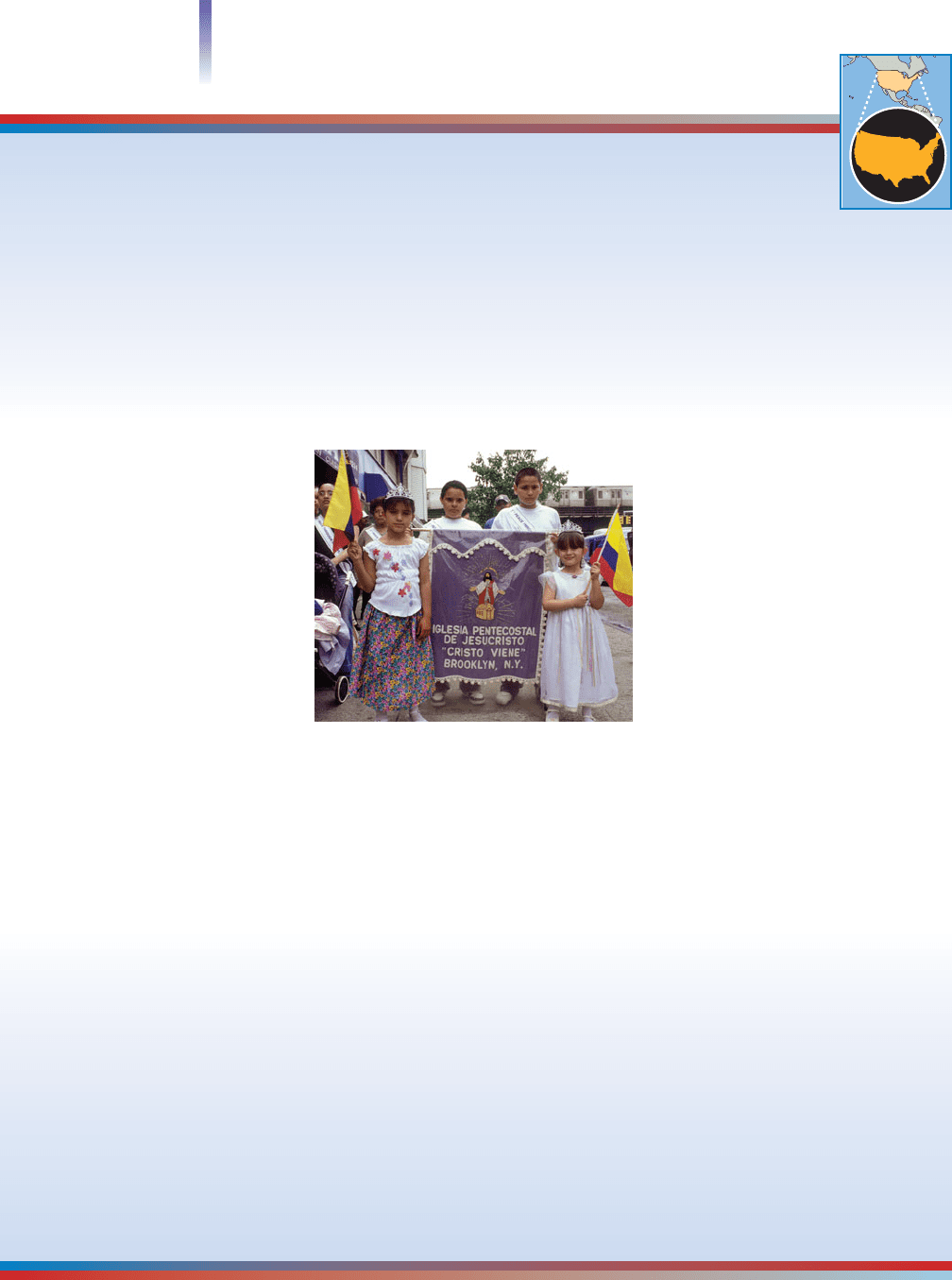
548 Chapter 18 RELIGION
Cultural Diversity in the United States
The New Face of Religion:
Pentecostals and the Spanish-
Speaking Immigrants
That millions of immigrants from Spanish-speaking
countries have become part of the U.S. social scene is
not news. That most of them are poor isn’t news, ei-
ther.Almost all the immigrants who came before them
were poor, too.
What is news is that many of
these Latinos are abandoning the
Roman Catholic religion and are
embracing a form of Protestantism
called Pentecostalism. Pentecostals,
often referred to by the derisive
term, holy rollers, take the Bible
literally. They believe there is a real
heaven and hell.They lay hands on
each other and pray for healings.
They expect God to act in their
lives in a personal way. They speak
in tongues.
And they are noisily joyful about
their faith.
Go into one of their storefront
churches, such as those on Amsterdam Avenue in New
York City—or in any of the thousands of little churches
that have sprung up around the country. You’ll hear
music and clapping. The preachers talk about a God
who is concerned about the troubles people are going
through. They warn the congregation, too, about the
dangers of sin—the adultery that seductively beckons;
the downfall of drugs and alcohol; the dead end of lazi-
ness and extravagance. They also extol the values of
thrift and hard work. As the preacher preaches, the
congregation breaks out into “Amens.” “Amen, brother!
Bring it on!” will shout one person, while another says,
“Amen, sister. Tell it like it is!”
The preachers know what they are talking about.
They work at factory jobs during the day. They know
what it is to sweat for a living and that J-O-B is really
spelled B-R-O-K-E. Cantankerous bosses, unpaid bills,
and paychecks that run out before the month does are
part of their own lives.
As people clap and sway to the sounds of the drums
and guitars—like salsa music with religious lyrics—some
pray silently in tongues. Others shout out the strange
sounds. Some tongues, they believe, are messages
straight from God. But no one can understand them un-
less someone else is given the interpretation. When this
happens, people listen intently for what God has to say
to them personally.
The worshippers don’t come just for an hour on
Sunday mornings. They come night
after night, finding comfort in com-
munity and encouragement in the
message and music.The services
also allow them to express their
emotions among like-minded peo-
ple.
Pentecostalism is the fastest-
growing religion in the United
States, and there are perhaps 400
million Pentecostals worldwide. Al-
though there are middle-class and
college-educated Pentecostals, the
middle-class arms don’t open as
wide.The appeal is mainly to the
poor. When the poor make the
transition to the middle class—as
their religion, with its emphasis on work and thrift will
help them do—they are likely to seek new forms of reli-
gious expression.
When this happens, we can expect that Pentecostal-
ism will also adapt, that the form will remain recogniza-
ble, but the fervor will be lost. For now, though, it is the
fervor—the intensity that connects the individuals to
God and to one another—that is the driving force of
this religion. The Pentecostals would phrase this a little
differently. They would say that the fervor is merely the
expression of the driving force of their religion, which is
the Holy Spirit.
Either way you put it, these people are on fire.And
that fire is burning a new imprint on the face of religion.
For Your Consideration
Why do you think the Pentecostals are growing so fast?
What effect do you think they might have on main-
stream Christianity?
Religion often helps immigrants adapt to their new
culture. What indications of this do you see in this
photo?
United States
United States
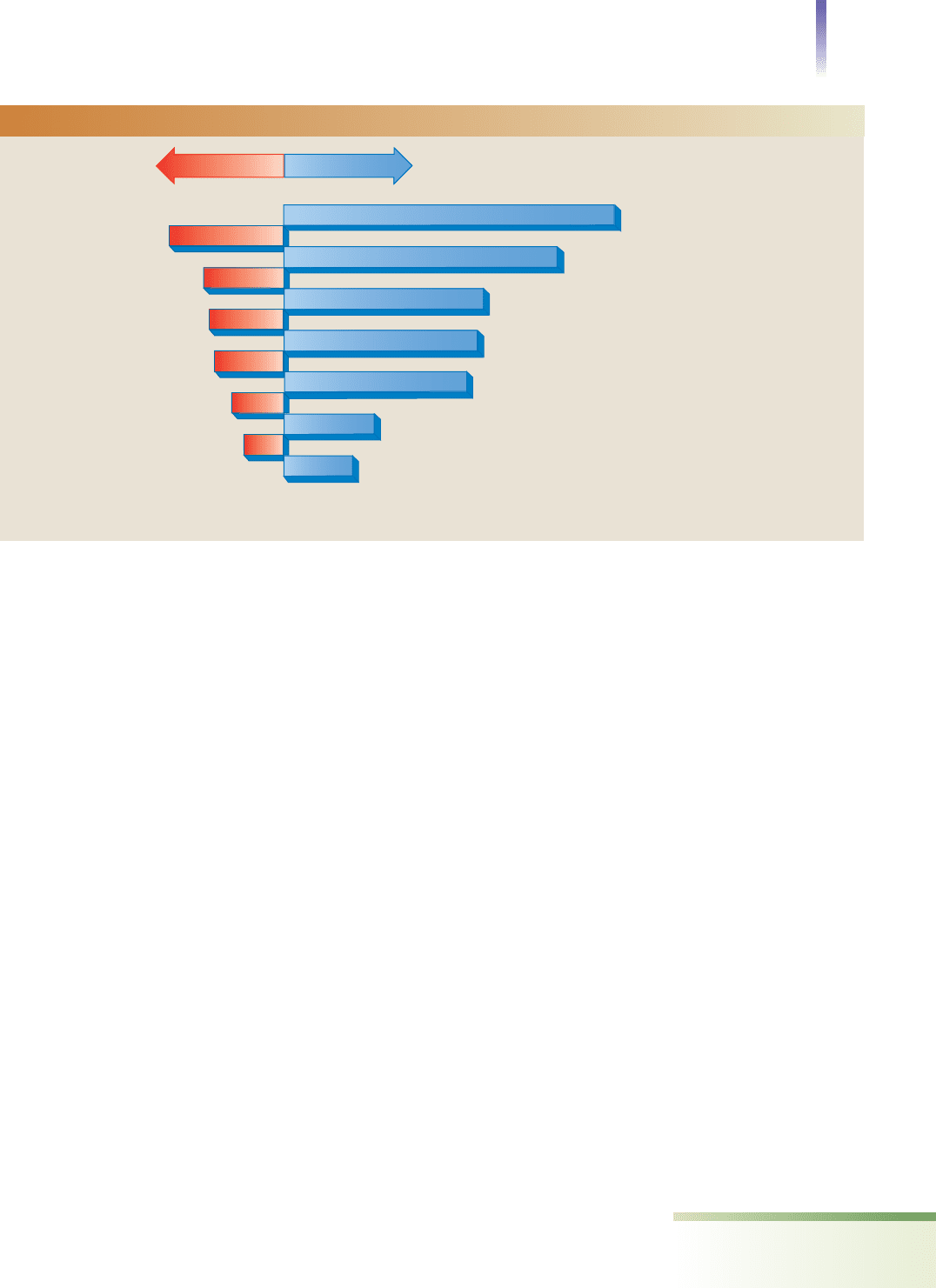
Religion in the United States 549
Secularization of Religion and Culture
The term secularization refers to the process by which worldly affairs replace spiritual in-
terests. (The term secular means “belonging to the world and its affairs.”) As we shall
see, both religions and cultures can become secularized.
The Secularization of Religion
As the model, fashionably slender, paused before the head table of African American com-
munity leaders, her gold necklace glimmering above the low-cut bodice of her emerald-
green dress, the hostess, a member of the Church of God in Christ, said, “It’s now OK to
wear more revealing clothes—as long as it’s done in good taste.” Then she added, “You
couldn’t do this when I was a girl, but now it’s OK—and you can still worship God.”
(Author’s files)
When I heard these words, I grabbed a napkin and quickly jotted them down, my so-
ciological imagination stirred by their deep implication. As strange as it may seem, this
simple event pinpoints the essence of why the Christian churches in the United States
have splintered. Let’s see how this could possibly be.
The simplest explanation for why Christians don’t have just one church, or at most
several, instead of the hundreds of sects and denominations that dot the U.S. land-
scape, is disagreements about doctrine (church teaching). As theologian and sociol-
ogist Richard Niebuhr pointed out, however, there are many ways of settling doctrinal
disputes besides splintering off and forming other religious organizations. Niebuhr
(1929) suggested that the answer lies more in social change than it does in religious
conflict.
The explanation goes like this. As was noted earlier, when a sect becomes more
churchlike, its members feel less tension with the mainstream culture. Quite likely,
when a sect is first established, its founders and first members are poor, or at least not
very successful in worldly pursuits. Feeling like strangers in the dominant culture,
they derive a good part of their identity from their religion. In their church services
and lifestyle, they stress how different their values are from those of the dominant cul-
ture. They are also likely to emphasize the joys of the coming afterlife, when they
will be able to escape from their present pain.
secular belonging to the
world and its affairs
Reformed 20%
African Methodist Episcopal 58%
Disciples of Christ 14%
Jehovah’s Witnesses 48%
Episcopal 13%
Seventh Day Adventists 35%
Presbyterian 12%
Assemblies of God 34%
United Church 9%
Mormons 32%
United Methodist 7%
Southern Baptist 16%
Roman Catholic 12%
Note: Mergers are excluded. Inconsistent reporting and classifications make it difficult to compare membership over time,
making these totals only approximate.
Percent Loss
Percent Gain
FIGURE 18.5 U.S. Churches: Gains and Losses in Ten Years
Source: By the author. Recomputed from Jones et al. 2002.

As time passes, the group’s values—such as frugality and the avoidance of gam-
bling, alcohol, and drugs—help the members become successful. As their children at-
tain more education and become more middle class, members of this group grow more
respectable in the eyes of society. They no longer experience the alienation that was felt
by the founders of their group. Life’s burdens don’t seem as heavy, and the need for re-
lief through an afterlife becomes less pressing. Similarly, the pleasures of the world no
longer appear as threatening to the “truth.” As with the woman at the fashion show,
people then attempt to harmonize their religious beliefs with their changing ideas
about the culture.
This process is called the secularization of religion—shifting the focus from spir-
itual matters to the affairs of this world. Anyone familiar with today’s mainstream
Methodists would be surprised to know that they once were a sect. Methodists used
to ban playing cards, dancing, and going to movies. They even considered circuses
to be sinful. As Methodists grew more middle class, however, they began to change
their views on sin. They started to dismantle the barriers that they had constructed
between themselves and the outside world (Finke and Stark 1992).
Secularization leads to a splintering of the group, for adjusting to the secular cul-
ture displeases some of the group’s members, especially those who have had less
worldly success. These people still feel a gulf between themselves and the broader
culture. For them, tension and hostility continue to be real. They see secularization
as a desertion of the group’s fundamental truths, a “selling out” to the secular world.
After futile attempts by die-hards to bring the group back to its senses, the group
splinters. Those who protested the secularization of Methodism, for example, were
kicked out—even though they represented the values around which the group had or-
ganized in the first place. The dissatisfied—who have come to be viewed as com-
plainers—then form a sect that once again stresses its differences from the world; the
need for more personal, emotional religious experiences; and salvation from the pain
of living in this world. As time passes, the cycle repeats: adjustment to the dominant
culture by some, continued dissatisfaction by others, and further splintering.
This process is not limited to sects, but also occurs in churches. When U.S. Epis-
copalians elected an openly gay bishop in 2003, some pastors and congregations
splintered from the U.S. church and affiliated with the more conservative African
archbishops. In an ironic twist, this made them mission congregations from Africa.
Sociologists have not yet compared the income or wealth of those who stayed with
the group that elected the gay bishop and those who joined the splinter groups. If
such a study is done and it turns out that there is no difference, we will have to mod-
ify the secularization thesis.
The Secularization of Culture. Just as religion can secularize, so can culture. Soci-
ologists use the term secularization of culture to refer to a culture that was once
550 Chapter 18 RELIGION
secularization of religion
the replacement of a religion’s
spiritual or “other worldly”
concerns with concerns about
“this world”
secularization of culture
the process by which a culture
becomes less influenced by
religion
In its technical sense, to evangelize means to “announce the Good News” (that Jesus is the Savior). In its
more common usage, to evangelize means to make converts. As Peanuts so humorously picks up,
evangelization is sometimes accomplished through means other than preaching.
